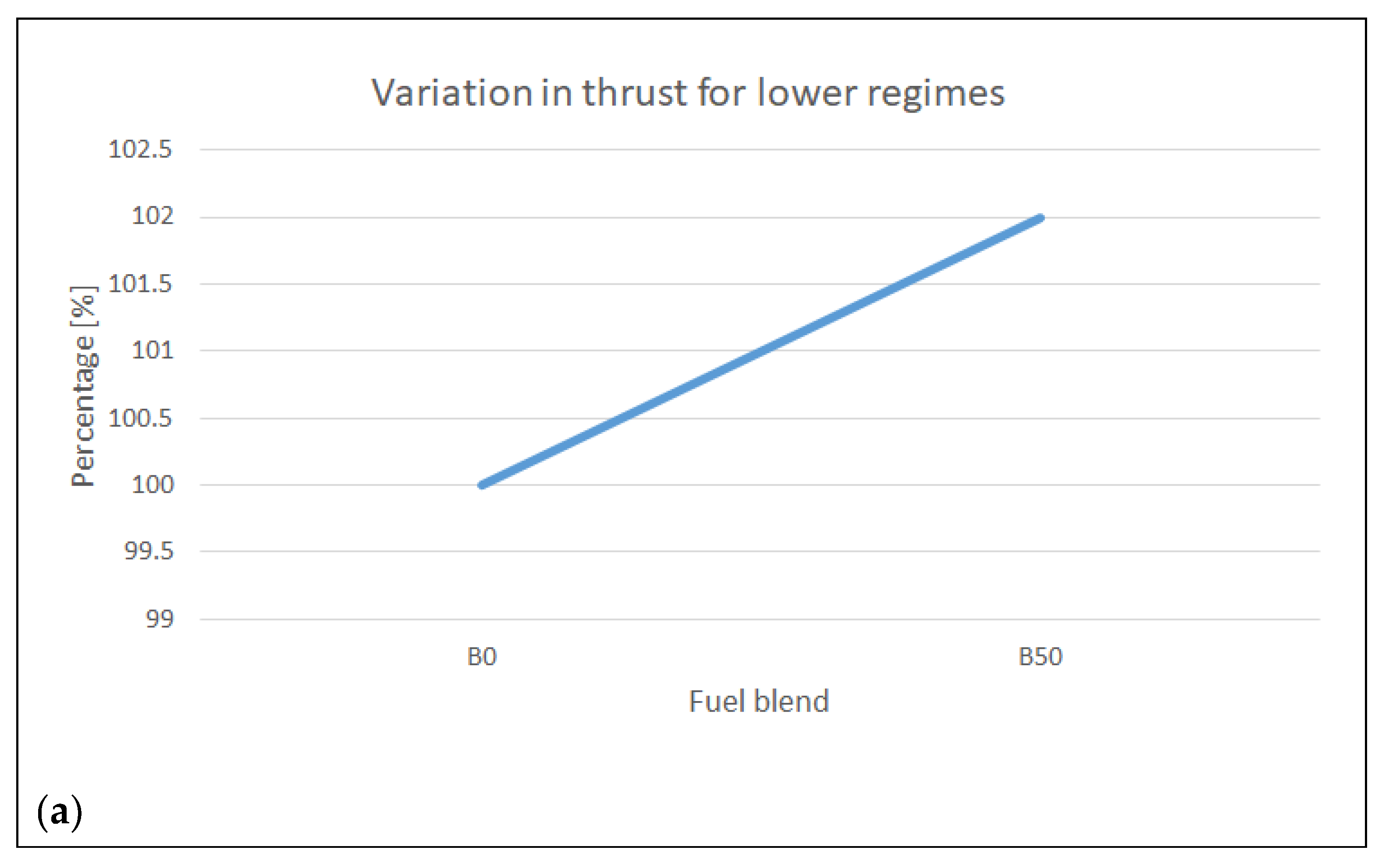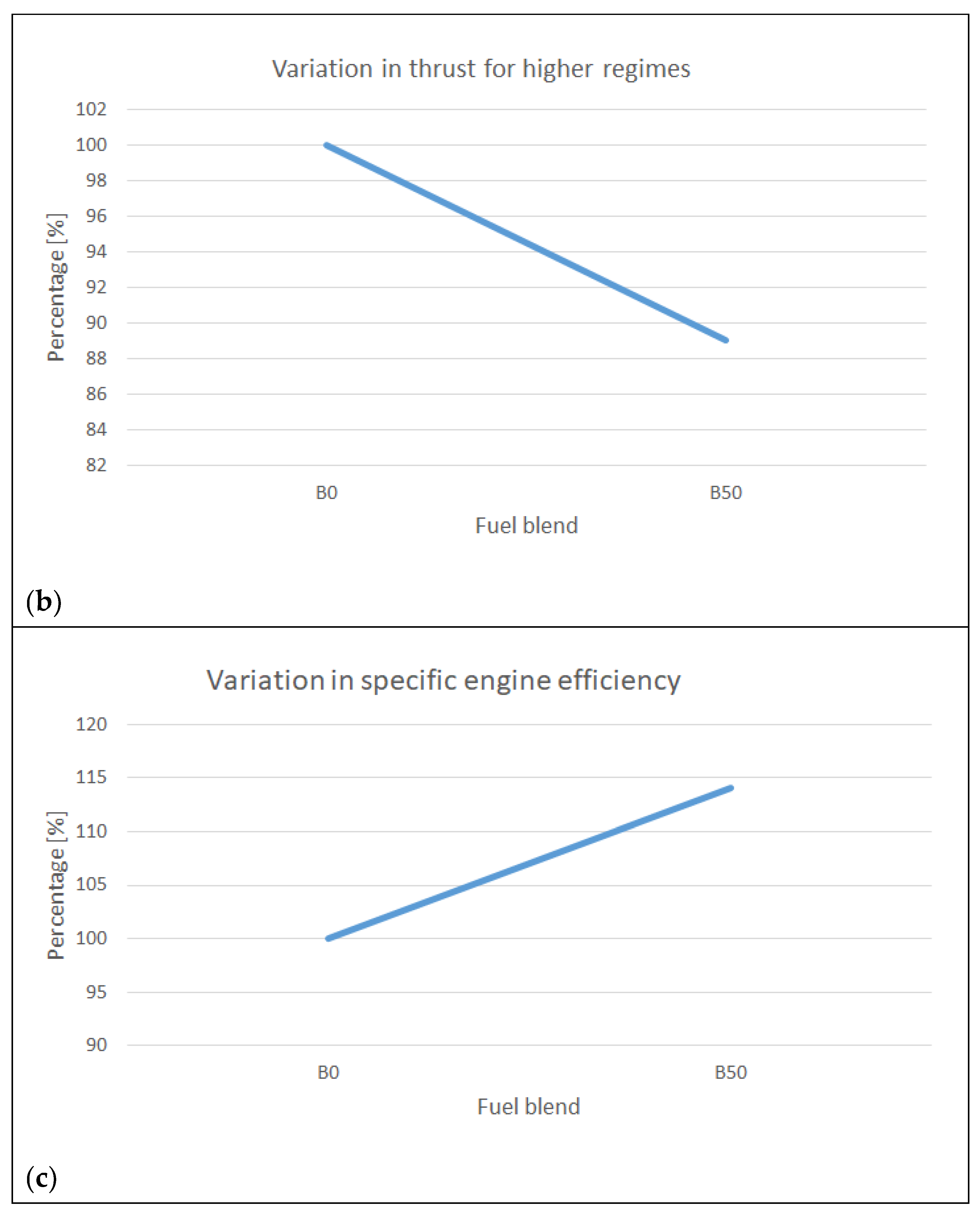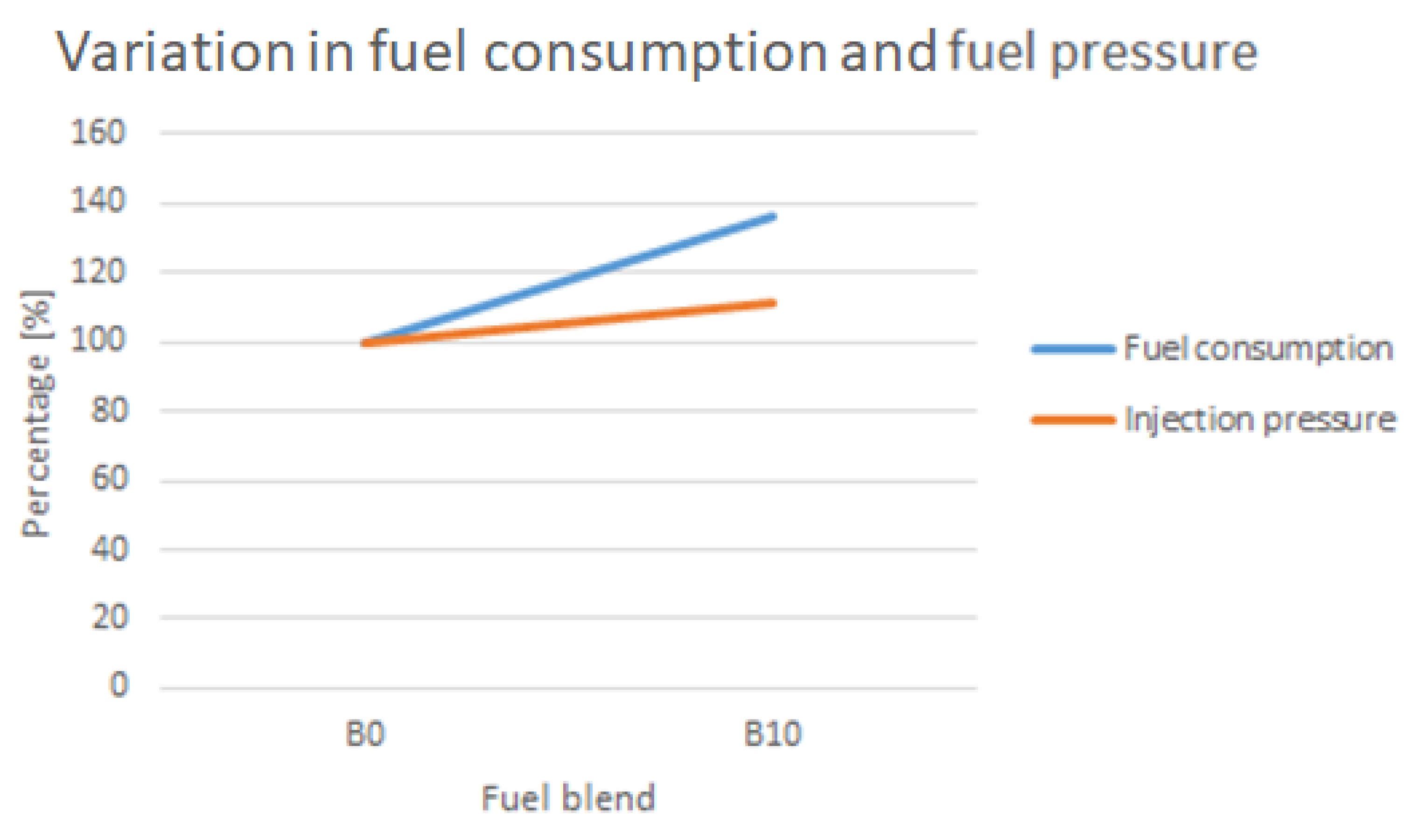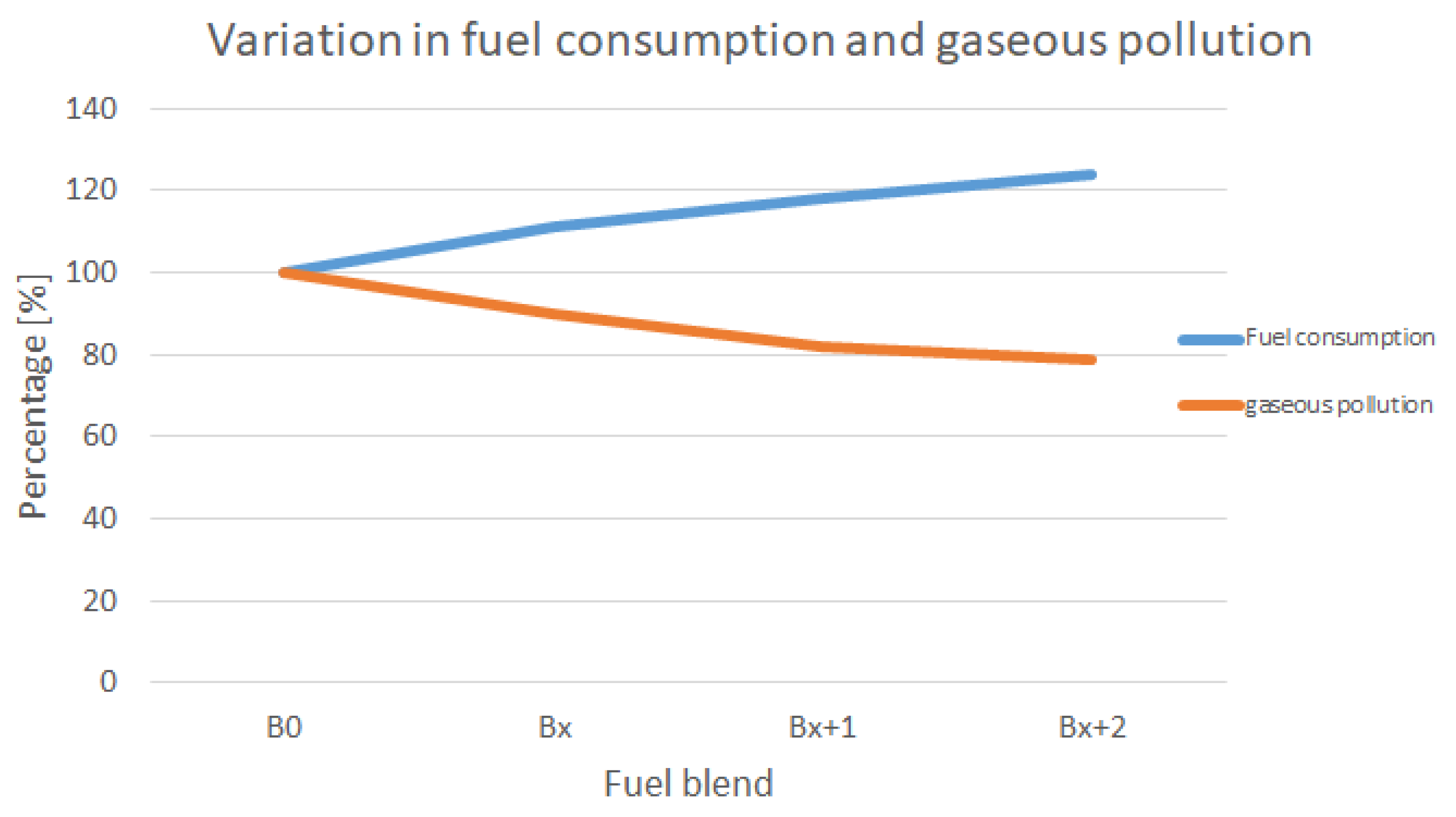The Use of Jet A Aviation Fuel Blended with Biodiesel and Alcohols as a Sustainable Aviation Fuel: A Review
Abstract
:1. Introduction
2. Fuel Blends and Their Impact on Engine Performance
2.1. Jet A and Alcohol Blends
2.1.1. Ethanol Blends
2.1.2. Methanol Blends
2.1.3. Butanol Blends
2.1.4. Pentanol Blends
2.1.5. Hexanol Blends
2.1.6. Heptanol Blends
2.1.7. Octanol Blends
2.2. Jet A and Biodiesel Blends
2.2.1. Thrust and Fuel Consumption
2.2.2. Combustion Efficiency and Thermal Performance
3. Comparative Analysis
3.1. Engine Stability and Performance
3.2. Fuel Properties and Engine Compatibility
4. Gaseous Emissions and Environmental Impact
4.1. Jet A and Alcohol Blends
4.1.1. Methanol Blends
4.1.2. Ethanol Blends
4.1.3. N-Butanol Blends
4.2. Jet A and Biodiesel Blends
4.2.1. Emission Profiles
4.2.2. Particulate Matter Emissions
4.3. Environmental Impact
4.3.1. Greenhouse Gas Emissions
4.3.2. Resource Utilization and Sustainability
5. Limitations and Challenges
- Material Compatibility—Alcohols, particularly ethanol, can act as solvents, potentially degrading fuel system components that are not designed for such fuels. This necessitates material compatibility assessments and possible modifications to existing fuel systems.
- Energy Density—Both ethanol and biodiesel have lower energy densities compared to Jet A fuel. This results in increased fuel consumption to achieve the same thrust, impacting the aircraft’s range and operational efficiency. Studies have shown that blending ethanol with Jet A fuel can affect engine performance. For instance, Andoga et al. [7] explored the use of ethanol in small turbojet engines and found that ethanol concentrations above 40% negatively impacted engine speed and thrust. The lower energy density of ethanol compared to Jet A results in reduced thrust and increased fuel consumption. Additionally, ethanol’s hygroscopic nature can lead to water contamination, posing risks to engine components. Moreover, ethanol’s solvent properties may degrade seals and hoses, leading to maintenance challenges.
- Hygroscopic Nature—Ethanol’s tendency to absorb water can lead to phase separation and microbial growth in fuel systems, posing risks of corrosion and fuel degradation.
- Emission Trade-offs—While reductions in CO and HC emissions are beneficial, the associated increase in NOx emissions presents a challenge. Mitigating NOx formation requires advanced combustion technologies or after-treatment systems, which may add complexity and weight to the aircraft. While ethanol blends can reduce certain emissions, they may increase others. Andoga et al. [7] reported that ethanol-blended fuels led to a decrease in carbon monoxide (CO) and unburned hydrocarbon (HC) emissions due to more complete combustion. However, there was an increase in nitrogen oxide (NOx) emissions, likely due to higher combustion temperatures. This trade-off highlights the need for advanced combustion control strategies to mitigate NOx emissions when using ethanol blends.
- Aromatic Content: The lack of aromatics in biodiesel affects fuel properties such as density and seal swell characteristics, which are crucial for engine performance and fuel system integrity. This limitation restricts the proportion of biodiesel that can be blended without compromising safety and performance. Ali et al. [4] reported that biodiesel blends resulted in reduced CO and HC emissions, likely due to the oxygen content in biodiesel promoting more complete combustion. However, there was an increase in NOx emissions, which could be attributed to higher flame temperatures. Furthermore, the absence of aromatics in biodiesel may affect the fuel’s lubricity and energy density, posing challenges for high-altitude operations where aromatics are required.
6. Future Perspectives
6.1. Technological Advancements
6.1.1. Alcohol-To-Jet (ATJ) Technology
6.1.2. Biodiesel Integration
6.2. Economic Considerations
6.2.1. Production Costs and Market Dynamics
6.2.2. Policy and Regulatory Support
6.3. Environmental Implications
6.3.1. Emission Reductions
6.3.2. Sustainability of Feedstocks
6.4. Future Outlook
7. Conclusions
- ➢
- Blending Jet A fuel with alcohols or biodiesel presents potential environmental benefits; however, significant gaps and limitations remain. Challenges such as material compatibility, energy density, hygroscopicity, emission trade-offs, and aromatic content require further investigation. Addressing these issues will necessitate the development of advanced materials, optimization of blend ratios, and the implementation of innovative combustion control strategies to ensure the viable integration of these alternative fuels into aviation.
- ➢
- The use of biodiesel as a blending agent with Jet A fuel offers both opportunities and challenges for turbojet engine performance. Lower concentrations of biodiesel can enhance specific fuel consumption and combustion efficiency, while higher concentrations may lead to thrust reduction and fuel property alterations. Continued research is crucial to refine blend ratios and develop engine technologies that can accommodate these fuels without compromising performance or safety.
- ➢
- Similarly, the integration of alcohols into Jet A fuel introduces both advantages and drawbacks. While lower concentrations may improve specific performance metrics, higher concentrations can negatively impact engine stability, fuel consumption, and material compatibility. Research efforts must focus on optimizing blending proportions and adapting engine technologies to maintain reliable and efficient operation.
- ➢
- From an environmental perspective, blending Jet A fuel with alcohols or biodiesel has shown promising results in reducing CO, HC, and particulate matter emissions, contributing to aviation sustainability. However, the increase in NOx emissions presents a significant challenge that requires further investigation into combustion optimization and emission control technologies. A comprehensive assessment of biofuels’ environmental impact should also account for their entire lifecycle, ensuring that production and usage align with broader sustainability goals.
- ➢
- Future advancements in biofuel integration will rely on interdisciplinary collaboration among researchers, industry leaders, and policymakers. Addressing technical and environmental challenges through continued innovation will be essential for achieving sustainable aviation fuel solutions without compromising engine performance and safety.
Funding
Data Availability Statement
Acknowledgments
Conflicts of Interest
References
- Mendez, C.J.; Parthasarathy, R.N.; Gollahalli, S.R. Performance and Emission Characteristics of Alcohol/Jet A Blends in a Small-Scale Gas Turbine Engine. Appl. Energy 2014, 118, 135–140. [Google Scholar] [CrossRef]
- Cican, G.; Mirea, R.; Rimbu, G. Experimental Evaluation of Methanol/Jet-A Blends as Sustainable Aviation Fuels for Turbo-Engines: Performance and Environmental Impact Analysis. Fire 2024, 7, 155. [Google Scholar] [CrossRef]
- Cican, G.; Mirea, R. An Experimental Insight on the Use of N-Butanol as Sustainable Aviation Fuel. Fire 2024, 7, 313. [Google Scholar] [CrossRef]
- Ali, A.H.H.; Ibrahim, M.N. Performance and Environmental Impact of a Turbojet Engine Fueled by Blends of Biodiesels. Int. J. Environ. Sci. Technol. 2017, 14, 1253–1266. [Google Scholar] [CrossRef]
- Talero, G.; Bayona-Roa, C.; Muñoz, G.; Galindo, M.; Silva, V.; Pava, J.; Lopez, M. Experimental Methodology and Facility for the J69-Engine Performance and Emissions Evaluation Using Jet A1 and Biodiesel Blends. Energies 2019, 12, 4530. [Google Scholar] [CrossRef]
- Şen, S. The effect of using triple bio-fuel blend with Jet-A on engine performance and emissions in mini-scale turbojet engine. Energy Sources Part A Recover. Util. Environ. Eff. 2024, 45, 4616–4632. [Google Scholar] [CrossRef]
- Andoga, R.; Főző, L.; Schrötter, M.; Szabo, S. The Use of Ethanol as an Alternative Fuel for Small Turbojet Engines. Sustainability 2021, 13, 2541. [Google Scholar] [CrossRef]
- Cheng, T.C.; Jo-Han, N. Limitations to sustainable renewable jet fuels production attributed to cost than energy-water-food resource availability. Nat. Commun. 2023, 14, 8156. [Google Scholar] [CrossRef]
- Cican, G.; Mirea, R. Performance and environmental impact of ethanol-kerosene blends as sustainable aviation fuels in micro turbo-engines. Int. J. Engine Res. 2024, 25, 2204–2214. [Google Scholar] [CrossRef]
- Kumar, M.; Cheng, T.C.; Karmakar, S.W. Combustion characteristics of butanol-Jet A-1 fuel blends in a swirl-stabilized combustor under the influence of preheated swirling air. Int. J. Energy Res. 2021. [Google Scholar] [CrossRef]
- Vishwanath, R.; Carniglia, P.A.; Weber, J.K.; Gulder, O.L. Effects of n-pentanol blending on soot formation in swirl-stabilized turbulent spray flames of Jet A-1 in a laboratory gas turbine combustor. Fuel 2024, 357, 129971. [Google Scholar] [CrossRef]
- Suchocki, T.; Kazimierski, P.; Lampart, P.; Janusewicz, K. A comparative study of pentanol (C5 alcohol) and kerosene blends in terms of gas turbine engine performance and exhaust gas emission. Fuel 2023, 334, 1–13. [Google Scholar] [CrossRef]
- Mirea, R.; Cican, G. Theoretical Assessment of Different Aviation Fuel Blends based on their Physical-Chemical Properties. Eng. Technol. Appl. Sci. Res. 2024, 14, 14134–14140. [Google Scholar] [CrossRef]
- Suchocki, T. Performance and Emission Characteristics of a Small Gas Turbine Engine Using Hexanol as a Biomass-Derived Fuel. Materials 2024, 17, 6011. [Google Scholar] [CrossRef]
- Yılmaz, N.; Vigil, F.M.; Atmanli, A.; Donaldson, B. Influence of Fuel Oxygenation on Regulated Pollutants and Unregulated Aromatic Compounds with Biodiesel and n-Pentanol Blends. Int. J. Energy Res. 2023. [Google Scholar] [CrossRef]
- Battal, D.; Cakmak, A.; Yesilyurt, M.K.; Erol, D. Investigation on 1-heptanol as an oxygenated additive with diesel fuel for compression-ignition engine applications: An approach in terms of energy, exergy, exergoeconomic, enviroeconomic, and sustainability analyses. Fuel 2020, 275, 117973. [Google Scholar] [CrossRef]
- Betgeri, V.; Prakash, B.; Pischinger, S. Investigation of the drop-in capabilities of a renewable 1-Octanol based E-fuel for heavy-duty engine applications. Energy 2023, 282, 128811. [Google Scholar] [CrossRef]
- Wang, J.; Sun, L.; Luan, P.; Wu, Y.; Cheng, Z.; Zhang, Z.; King, X.; Liu, H.; Chen, G. Effect of diesel blended with di-n-butyl ether/1-octanol on combustion and emission in a heavy-duty diesel engine. Environ. Pollut. 2022, 311, 119977. [Google Scholar] [CrossRef]
- Altarazi, Y.S.M.; Talib, A.R.A.; Gires, E.; Yu, J.; Lucas, J.; Yusaf, T. Performance and Exhaust Emissions Rate of Small-Scale Turbojet Engine Running on Dual Biodiesel Blends Using GasTurb. Energy 2021, 232, 120971. [Google Scholar] [CrossRef]
- Gawron, B.; Białecki, T. Impact of a Jet A-1/HEFA blend on the performance and emission characteristics of a miniature turbojet engine. Int. J. Environ. Sci. Technol. 2018, 15, 1501–1508. [Google Scholar] [CrossRef]
- Feser, J.; Gupta, A. Performance and Emissions of Drop-In Aviation Biofuels in a Lab-Scale Turbine Combustor. J. Energy Resources Technol. 2021, 143, 042103. [Google Scholar] [CrossRef]
- Available online: https://www.nasa.gov/news-release/nasa-study-confirms-biofuels-reduce-jet-engine-pollution/ (accessed on 24 February 2025).
- Gholami, A.; Pourfayaz, F.; Saifoddin, A. Techno-economic assessment and sensitivity analysis of biodiesel production intensified through hydrodynamic cavitation. Energy Sci. Eng. 2021, 9, 1997–2018. [Google Scholar] [CrossRef]
- Available online: https://www.reuters.com/business/energy/chinas-biodiesel-producers-seek-new-outlets-hefty-eu-tariffs-bite-2024-08-16/?utm_source=chatgpt.com (accessed on 6 March 2025).
- Mizik, T.; Gyarmati, G. Economic and Sustainability of Biodiesel Production—A Systematic Literature Review. Clean Technol. 2021, 3, 19–36. [Google Scholar] [CrossRef]




| Percent [%] | Properties | Propanol | Butanol | Pentanol | Hexanol | Heptanol | Octanol |
|---|---|---|---|---|---|---|---|
| 10% | Density at 25 °C | 0.7880 | 0.7897 | 0.7909 | 0.7912 | 0.7919 | 0.7954 |
| Viscosity at 25 °C | 1.4182 | 1.4685 | 1.5257 | 1.5695 | 1.6097 | 1.7330 | |
| 20% | Density at 25 °C | 0.7895 | 0.7920 | 0.7934 | 0.7942 | 0.7950 | 0.7971 |
| Viscosity at 25 °C | 1.5185 | 1.5695 | 1.6568 | 1.7584 | 1.8635 | 2.0140 | |
| 30% | Density at 25 °C | 0.7922 | 0.7942 | 0.7965 | 0.7975 | 0.7991 | 0.8009 |
| Viscosity at 25 °C | 1.6326 | 1.7114 | 1.8647 | 2.0466 | 2.1482 | 2.3920 |
| Sample | Flash Point | Viscosity at 40 °C | Density at 22 °C | Freezing Point | Higher Calorific Value |
|---|---|---|---|---|---|
| °C | cSt | g/cm3 | °C | kJ/kg | |
| Ke + 5% Aeroshell | 42.3 | 1.39 | 0.817 | <−35 °C | 45.292 |
| Ke + 10% BDpork | 44.2 | 1.51 | 0.823 | <−35 °C | 44.403 |
| Ke + 20% BDpork | 50.2 | 1.82 | 0.830 | <−35 °C | 43.67 |
| Ke + 30% BD pork | 54.7 | 2.06 | 0.836 | −29 °C | 43.302 |
| Ke + 50% BDpork | 57 | 2.62 | 0.850 | −23 °C | 41.997 |
| 100% BDpork | 161 | 5.08 | 0.875 | −6 °C | 39.323 |
Disclaimer/Publisher’s Note: The statements, opinions and data contained in all publications are solely those of the individual author(s) and contributor(s) and not of MDPI and/or the editor(s). MDPI and/or the editor(s) disclaim responsibility for any injury to people or property resulting from any ideas, methods, instructions or products referred to in the content. |
© 2025 by the author. Licensee MDPI, Basel, Switzerland. This article is an open access article distributed under the terms and conditions of the Creative Commons Attribution (CC BY) license (https://creativecommons.org/licenses/by/4.0/).
Share and Cite
Mirea, R. The Use of Jet A Aviation Fuel Blended with Biodiesel and Alcohols as a Sustainable Aviation Fuel: A Review. Energies 2025, 18, 1575. https://doi.org/10.3390/en18071575
Mirea R. The Use of Jet A Aviation Fuel Blended with Biodiesel and Alcohols as a Sustainable Aviation Fuel: A Review. Energies. 2025; 18(7):1575. https://doi.org/10.3390/en18071575
Chicago/Turabian StyleMirea, Radu. 2025. "The Use of Jet A Aviation Fuel Blended with Biodiesel and Alcohols as a Sustainable Aviation Fuel: A Review" Energies 18, no. 7: 1575. https://doi.org/10.3390/en18071575
APA StyleMirea, R. (2025). The Use of Jet A Aviation Fuel Blended with Biodiesel and Alcohols as a Sustainable Aviation Fuel: A Review. Energies, 18(7), 1575. https://doi.org/10.3390/en18071575






